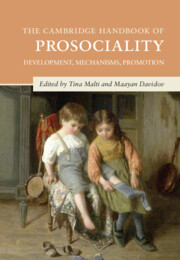Book contents
- The Cambridge Handbook of Prosociality
- Cambridge Handbooks in Psychology
- The Cambridge Handbook of Prosociality
- Copyright page
- Dedication
- Contents
- Figures
- Contributors
- Part I Development of Prosociality
- 1 Introduction: What Is Prosocial Development?
- 2 Developmental Theories of Prosociality
- 3 The Role of Genetics in the Development of Prosocial Behavior
- 4 Neurobiology of Prosociality
- 5 The Developmental Psychophysiology of Prosociality
- 6 The Origins of Prosociality from a Developmental and Comparative Perspective
- 7 Prosocial Behavior in Infancy and Early Childhood
- 8 Prosociality in Middle Childhood
- 9 Prosocial Behaviors in Adolescence
- 10 Prosocial Development across the Lifespan
- Part II Antecedents and Mechanisms of Prosociality
- Part III Development of Prosociality in Context
- Part IV Applications
- Index
- References
8 - Prosociality in Middle Childhood
from Part I - Development of Prosociality
Published online by Cambridge University Press: 25 May 2023
- The Cambridge Handbook of Prosociality
- Cambridge Handbooks in Psychology
- The Cambridge Handbook of Prosociality
- Copyright page
- Dedication
- Contents
- Figures
- Contributors
- Part I Development of Prosociality
- 1 Introduction: What Is Prosocial Development?
- 2 Developmental Theories of Prosociality
- 3 The Role of Genetics in the Development of Prosocial Behavior
- 4 Neurobiology of Prosociality
- 5 The Developmental Psychophysiology of Prosociality
- 6 The Origins of Prosociality from a Developmental and Comparative Perspective
- 7 Prosocial Behavior in Infancy and Early Childhood
- 8 Prosociality in Middle Childhood
- 9 Prosocial Behaviors in Adolescence
- 10 Prosocial Development across the Lifespan
- Part II Antecedents and Mechanisms of Prosociality
- Part III Development of Prosociality in Context
- Part IV Applications
- Index
- References
Summary
Children in middle childhood, from about ages 6 to 12, are developing increased competencies that affect the ways in which they interact with others. Additionally, their contexts change, as they typically begin formal schooling and are exposed to different opportunities, challenges, and individuals with whom they interact. Considering these changes, it is important to consider both how these impact children’s prosocial development and how their prosocial behaviors support their development. In this chapter, we review the development of prosociality in middle childhood, highlighting key issues and central research findings, centering on the developmental tasks that are key to this age period. We also discuss issues and considerations in assessing prosocial development in middle childhood. Finally, we consider the implications for promoting a more just society through the promotion of prosociality and highlight future considerations for research.
- Type
- Chapter
- Information
- The Cambridge Handbook of ProsocialityDevelopment, Mechanisms, Promotion, pp. 145 - 162Publisher: Cambridge University PressPrint publication year: 2023



